Myanma Railways use diesel traction. A handful of steam locomotives were kept serviceable until a few years ago, but I'm not sure whether any remain in use.
This is a very informal listing of types of diesel traction I've come across. Since first publishing this article, I have received additional information from a correspondent who was involved in the delivery and commissioning of the DD.1500 class. I've incorporated this information, with thanks. He is the author of an excellent article published in the August 2013 edition of 'Railway Gazette International' titled 'MR eyes a 10 000 km network' and is currently completing a much-anticipated book on the history of railways in Myanmar.
Locomotives
When diesel locomotives replaced steam in Myanmar, they were sourced from Europe. Japan supplied a number of smaller diesel locomotives. Following the military takeover, for many years, Myanmar was regarded a pariah state so even obtaining spares for their existing diesel locomotives became problematic. Relations with China developed during this period and there are a number of Chinese diesel locomotives. Second-hand diesel locomotives from India were also acquired.
Railcars
Japan supplied a number of railcars - see my post Diesel Railcars in Burma for more details. Myanmar managed to build some single-cab Very-Lightweight Diesel Railcars incorporating bus parts.
Running numbers
Locomotives
Running numbers for locomotives comprise two letters followed by three or four digits (sometimes with a suffix digit). The first letter is 'D', presumably for 'Diesel'. No distinction is made between diesel electric, diesel hydraulic and mechanical transmission. The second letter indicates number of axles - 'B' and 'C' for 2- and 3-axle locomotives but I've not seen examples. I've seen 'D' (4-axle) and 'F' (6-axle) locomotives. On six-axle machines, no distinction is made between locomotives carried on two 6-wheel bogies and those carried on three 4-wheel bogies. The first one or two digits of the running number indicate the nominal horsepower (in units of 100 h.p.). The last two digits identify a particular locomotive. 1200 h.p. locomotives built in Insein Works carry a suffix digit. Within each horsepower class, there may be sub-classes which are not separately identified. Locomotives can have 'chopper' or 'buckeye' couplings and be fitted with vacuum brakes or air brakes (or both) to provide a train brake and, again, this is not separately identified.
Railcars
Railcar numbers comprise three letters followed usually by three or four digits to identify the class member. The first letter is 'R' (railcar) followed by 'B' (bogie). Although there are certainly 4-wheel railcars, I've not found a classification letter for that arrangement. The third letter is 'E' (engine - a powered car) or 'T' (trailer - an unpowered car). Recently-introduced railcars appear to have the class member represented by a 'P' followed by four digits.
Livery
Locomotives
Locomotives have a wide range of liveries. Some may indicate the manufacturer.
A common livery is cream (upper body) and brown (lower body) with a blue waistline. Since many coaches share this livery, I think of it as the 'standard'. Locomotives often have a grey solebar.
500 h.p. locomotives are light blue (upper body) dark blue (lower body) with a white waistline.
900 h.p. locomotives around Yangon are in a striking livery: cream (upper body) narrow orange (lower body) with broad blue and narrow red waistlines. Elsewhere, the 'standard' cream and brown livery is adopted.
1100 h.p. locomotives are either blue with a white waistline and cream solebar or green with a partial white waistline and white solebar.
1200 h.p. locomotives can be orange (upper body) and brown (lower body) with a white waistline or cream (upper body), light blue (lower body) with a red waistline or 'standard' cream and brown.
1300 h.p. locomotives are usually in 'standard' livery with grey solebars.
1500 h.p. locomotives I've seen have also been in the 'standard' livery but with black 'solebars' (actually, black lower body, below the brown).
1600 h.p. locomotives I've seen have been orange (upper body), brown (lower body) with a white waistline and grey solebars.
2000 h.p. locomotives appear in red (upper body) and Blue (lower body and solebar) with a white waistline, cream (upper body) and blue (lower body and solebars) with a red waistline and in 'standard' cream and brown with a blue waistline, but with orange solebars.
There's a lot more variability in detail between locomotives than the above suggests, particularly in the treatment of the ends of locomotives. Paint shades vary: 'cream' sometimes appears almost white and 'brown' can be 'maroon'. I don't know whether this is intentional or the effect of aging or other cause.
Railcars
Until recently, I'd only seen bogie railcars in cream (top) and red (bottom) but recently-introduced railcars carry full-colour advertising. The Very-Lightweight Diesel Railcar I've seen had a white body with grey near the bottom and a red waistline. The roof was yellow (extending downwards over the driving end) with a red roof-line.
Repowering
Some locomotives have received an uprated engine. Details are signwritten on the bodywork for easy identification. Uprated engines are either CAT from the U.S.A., MGO or Chinese. The DD15 class received MTU engines.
Locomotive Classes
500 h.p.
All locomotives are single-cab diesel-hydraulic carried on two 4-wheel bogies (B-B). They are from various manufacturers in Japan. There's a nice model of Kawasaki-built DD.506 in Myanma Railway Museum, Naypyidaw, although cab design differs from those I've seen. The data given is:-
| Type | Diesel Hydraulic |
| Maker | Kawasaki |
| Wheel Arrangement | B-B |
| Manufactured | 1978 |
| Rated Horsepower | 500 |
| Overall Length | 11390mm (37'4.5") |
| Overall Width | 2810mm (9'2.5") |
| Overall Height | 3840mm (11'5") |
| Weight in working order | 37.6 tons |
| Axle Load | 9.4 tons |
| Maximum Speed | 40 km/h (25 m.p.h.) |
| Diesel Engine | 6V396TC11 MTU, Germany |
| Hydraulic Transmission | L4r2U2 Fuji-Voith |
| Bogie | 4-wheel Rigid Bolster Type |
| Brake System | Air, Hydrodynamic, Hand Brake |
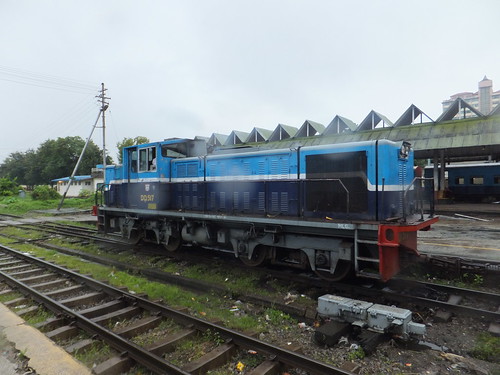 DD.517 at Yangon Central Station in the rain.
DD.517 at Yangon Central Station in the rain.
500 h.p. Photographs.
900 h.p.
All locomotives are single-cab carried on two 4-wheel bogies (Bo-Bo). There are sub-classes.
900 h.p. locomotives around Yangon are in the cream and orange livery with a plain nose at the 'front', cab at 'back'. But they normally run on the Circle Line cab-leading. I don't know whether this is for visibility or ventilation (the centre cab door is usually left open). At least one has been re-engined - DD.931 carries the marking CAT3512 (642kW)(860 h.p.), together with the information 'Weight 48t Length 39'10 1/2" '. There's data on the CAT3512B Generating Sets here.
Elsewhere, 900 h.p. models have a radiator in the flat nose and a short hood at the cab end. They normally carry the 'standard' brown and cream livery.
I'm told the class is divided into four types:-
901-906 Krupp DH (1969)It's believed only two of the Alsthom DE are still in service (I spotted DD934 and DD940 in April 2014).
907-913 KSK DH (1971)
914-942 Alsthom DE (1975)
943-969 Krupp DH (1978-1987)
 DD.931 running round its Circle Line train at Pa Ywet Seit Gone.
DD.931 running round its Circle Line train at Pa Ywet Seit Gone.
900 h.p. Photographs
1100 h.p.
All locomotives are single-cab carried on two 4-wheel bogies (Bo-Bo) and are assumed diesel-electric. Believed to be Chinese - certainly, DD.1145 carries a 1983 worksplate from the Sifang Loco and Rolling Stock Works in the P.R.C. Some cabs are flat ended but others have a bulge, like a vestigial low hood. There are two paint schemes - blue and green.
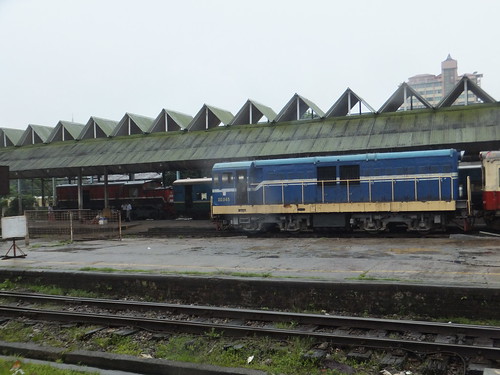 DD.1145 about to depart eastbound from Yangon Central station with a local passenger train.
DD.1145 about to depart eastbound from Yangon Central station with a local passenger train.
1100 h.p. Photographs
1200 h.p.
All locomotives are diesel-electric carried on three 4-wheel bogies (Bo-Bo-Bo) but there are a number of sub-classes.
Early units from Alsthom are dual-cab with slightly rounded ends with vertical windscreens. Some are marked 'Length: 49'10-9/16" Weight 71 tons." Later units from Alstom have rounded ends but with sloping windscreens. Chinese examples are dual cab, with a very angular body and sloping windscreens. DF.1267 (in cream and pale blue livery carries a 1995 worksplate from the Sifang Loco and Rolling Stock Works in the P.R.C. Some locomotives were built in Insein Works and carry a suffix digit. They use the CAT3508B marine engine, coupled to a Chinese generator. There is at least one single cab locomotive (DF.1202), which looks rather odd.
There's a nice model of Insein-built DF.1200-08 with 'CAT' prime mover in the Myanma Railway Museum, Naypyidaw. The data given for the Insein Locomotives is:-
| Type | Diesel Electric |
| Maker | Insein Locomotive Workshop, Myanmar |
| Axle Arrangement | Bo-Bo-Bo |
| Constructed | 2010 |
| Rated Horsepower | 1200 |
| Overall Length | 15204mm (49'10.5") |
| Overall Width | 2816mm (9'3") |
| Overall Height | 3450mm (11'3.75") |
| Weight in working order | 68 tons |
| Axle Load | 11.33 tons |
| Maximum Speed | 90 km/h (56 m.p.h.) |
| Gear Ratio | 92:19 |
| Diesel Engine | CAT3508B (Electronic), USA |
| Main Generator | JF205F, Yongji, China |
| Auxiliary Generator | JGL405, Yongji, China |
| Traction Motor | ZD110, Yongji, China |
| Bogie | R109 Alstom, France |
| Brake System | Air |
I've travelled in the cab of DD.1263 around the Circle Line in Yangon. That's described in the post Cab Ride around the Circle Line, with notes about the Driving Controls and links to pictures showing the cab layout.
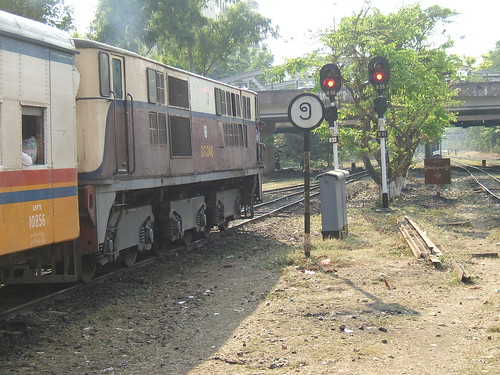 DF.1248 in brown & cream livery awaiting signal R56 at Yangon Central before commencing another clockwise circuit.
DF.1248 in brown & cream livery awaiting signal R56 at Yangon Central before commencing another clockwise circuit.
1200 h.p. Photographs
1300 h.p.
All locomotives are single-cab diesel-electric carried on two 6-wheel bogies (Co-Co) and are refurbished 'YDM4' locomotives from India, which had a large fleet, originally supplied by Alco (their type DL535A) but later built in India. The excellent Indian Railways Fan Club website gives more information of the YDM4 class here and here.
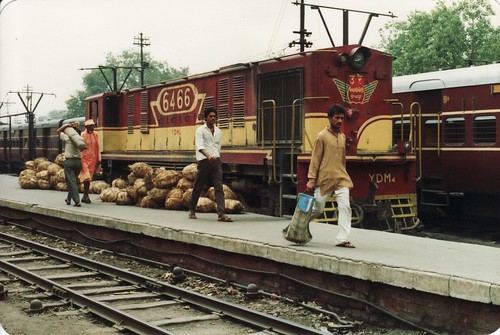 My picture of YDM4 6466 at Delhi Junction, Northern Railways, India taken in 1992.
My picture of YDM4 6466 at Delhi Junction, Northern Railways, India taken in 1992.
Ten refurbished YDM4 were supplied to Myanmar in 2000, with a further 20 in 2011. An article in 'The Hindu' here shows three locomotives (including DF.1344) setting off from the Golden Rock Railway Workshop for Myanmar.
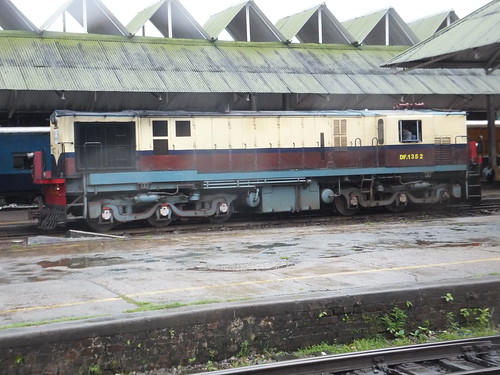 DF.1352 1300 h.p. Co-Co in Yangon Central Station.
DF.1352 1300 h.p. Co-Co in Yangon Central Station.
At least one of the refurbished locomotives (DF.1307) has been marked 'YDM4' on the 'buffer' beam.
1300 h.p. Photographs
1500 h.p.
The class comprises 28 locomotives DD1501 to DD1528 supplied in 1964. They were built by Fried Krupp Maschinenfabriken in Essen but were supplied under the 'brand name' Krauss-Maffei. All locomotives are dual-cab diesel-hydraulic carried on two 4-wheel bogies (B-B). They are very similar to types supplied to Thailand. DD.1521 is marked "Length: 42' 7-7/16" Weight: 49 tons."
In 2010 I travelled in the cab of DD.1527 from Katha to Naba and back. There's a post on the outward journey here with links to a post on the return journeys and to my photographs (including pictures showing cab layout). In 2012 a repeated the trip (not in the cab) as described here, with links to my pictures.
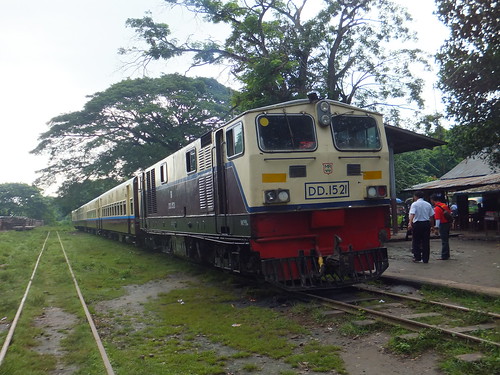 DD.1521 at Katha with a 'Road to Mandalay' special train to Naba.
DD.1521 at Katha with a 'Road to Mandalay' special train to Naba.
1500 h.p. Photographs
1600 h.p.
These locomotives are dual-cab diesel-electric carried on three 4-wheel bogies (Bo-Bo-Bo) and appear to be an uprated version of the 1200 h.p. locomotives. From the rounded corners and vertical cab windows they were supplied by Alstom. Some have been re-engined. For instance, DF.1631 and DF.1627 carry the marking 'A8V190ZL' together with the information 'Weight 73t Length 49'10 9/16" '. The diesel engine is Chinese, from Jinan Diesel Engine Co. Ltd, intended as part of a generating set and there's more data here. The solebar of the DF.1631 carries the marking "REPOWER.ISN.9.2009", indicating the work was done at the Insein Workshops. DF.1627 is marked "REPOWER.ISN.6.2009". DF.1637 has been uprated to 2000 h.p. with the fitting of an MOD6V170 (?) engine.
 DF.1610 at Pazundaung heading towards Mahlwagon with a train of bogie tanks.
DF.1610 at Pazundaung heading towards Mahlwagon with a train of bogie tanks.
1600 h.p. Photographs
2000 h.p.
These are the most powerful locomotives I've seen in Myanmar and appear to be a 'stretch' of the 1600 h.p. locomotives (which themselves 'stretched' the earlier 1200 h.p. design). They are dual-cab diesel-electric carried on three 4-wheel bogies. Yunnan Machinery & Equipment Import & Export Co.,Ltd (YMEC) first supplied the type in 1991, receiving an order for 20 off in 2007. There's a brief report on their website here. The Chinese CNR Corporation delivered 22 of their CKD7 locomotives to Myanmar from their Dalian Works since 1993 in 3 batches. Their report here describes 20 locomotives (including DF.2047) in red/blue livery being despatched in December 2008. The CKD7 design is described here. The CKD7 uses the CAT3516A described here with AC/DC transmission. Union Resources and Engineering Co. Ltd. also took credit for the despatch of these locomotives.
2000 h.p. Photographs
Book Illustrations
Various locomotive types are illustrated in a book (in Burmese) my friend showed me. I believe the title translates as '100 years of Burma Railways 1877 - 1977':-
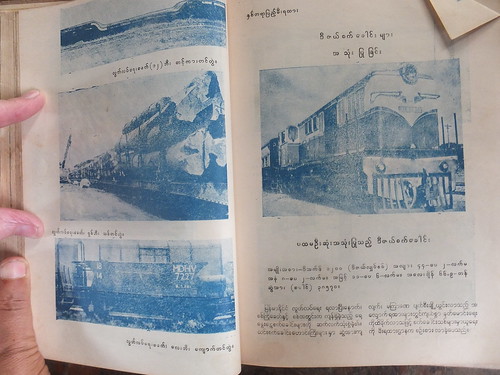 The page on the right possibly shows a 1300 h.p. locomotive.
The page on the right possibly shows a 1300 h.p. locomotive.
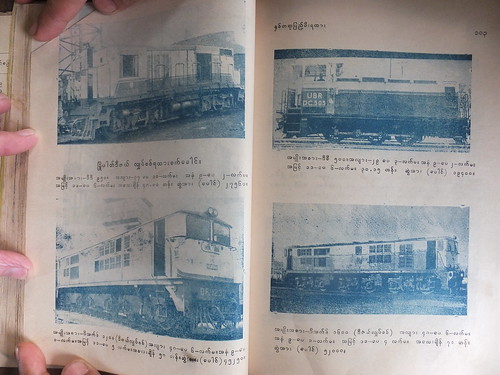 Top left: Possibly a 900 h.p. Bo-Bo. Bottom left: Alstom 1200 h.p. Bo-Bo-Bo. Top right: Three-axle jackshaft drive shunter. Bottom right: Alstom Bo-Bo-Bo.
Top left: Possibly a 900 h.p. Bo-Bo. Bottom left: Alstom 1200 h.p. Bo-Bo-Bo. Top right: Three-axle jackshaft drive shunter. Bottom right: Alstom Bo-Bo-Bo.
 Top left: 1500 h.p. Krauss Maffei B-B. Bottom left: Unidentified 4-axle Loco. Top right: Unidentified 4-axle Loco. Bottom right: Diesel Railcar (believed withdrawn).
Top left: 1500 h.p. Krauss Maffei B-B. Bottom left: Unidentified 4-axle Loco. Top right: Unidentified 4-axle Loco. Bottom right: Diesel Railcar (believed withdrawn).
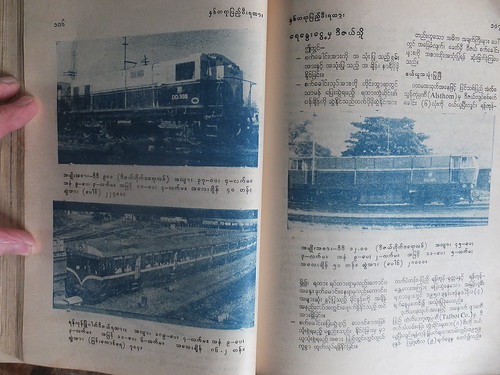 Top left: Unidentified 4-axle Loco. Bottom left: Diesel Railcar (believed withdrawn). Right: Unidentified 4-axle Loco.
Top left: Unidentified 4-axle Loco. Bottom left: Diesel Railcar (believed withdrawn). Right: Unidentified 4-axle Loco.
[Revised 1-Jan-2015 to incorporate additional information.]
